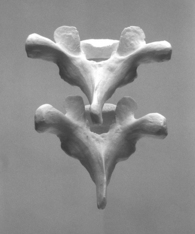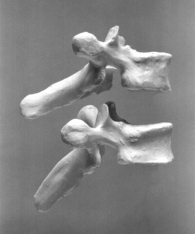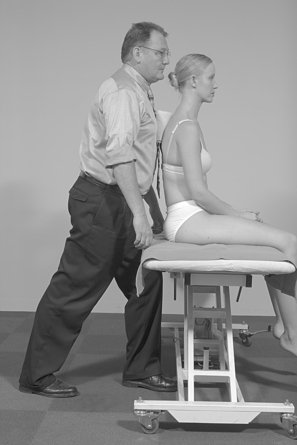8.21 Cervicothoracic spine C7–T3
Extension gliding
Assume somatic dysfunction (S-T-A-R-T) is identified and you wish to use an extension gliding thrust, parallel to the apophysial joint plane, to produce joint cavitation at T2–3 (Figs 8.106, 8.107).
2 Applicators
(a) Operator’s sternum, with a cushion or small rolled towel, applied to the T3 spinous process (Fig. 8.108)
4 Operator stance
Stand directly behind the patient with your feet apart and one leg behind the other. Bend your knees slightly to lower your body.
5 Positioning for thrust
Place the thrusting part of your sternum, with a cushion or small rolled towel, firmly against the spinous process of T3. Place your hands between the patient’s chest and upper arms to take hold of the patients’ forearms (Fig. 8.109). Maintaining your grip on the forearms ask the patient to put their hands behind their neck with fingers intertwined (Fig. 8.110). This results in your forearms contacting the patient’s axillae. Lean forwards with the thrusting part of your chest against the spinous process of T3 and introduce a backwards and compressive force to the patient’s arms and axillae. These combined movements introduce local extension to the thoracic spine. By balancing these different leverages, the tension can be localized to the T2–3 segment. Maintaining all holds and pressures, bring the patient backwards until your body weight is evenly distributed between both feet.
Stay updated, free articles. Join our Telegram channel

Full access? Get Clinical Tree
















